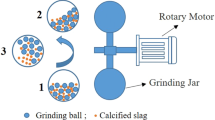Abstract
Results of an experimental study of limestone material finely ground in water using an electro-hydropulse technique are reported. The effect of the average particle size and inequigranularity of the material on the grinding efficiency is considered. The theoretical aspects of fine grinding by this method and the role of cavitation are outlined.
Similar content being viewed by others
Author information
Authors and Affiliations
Additional information
__________
Translated from Novye Ogneupory, No. 3, pp. 41 – 43, March, 2005.
Rights and permissions
About this article
Cite this article
Vinogradov, B.V., Fedin, D.A. Experimental and Theoretical Study of Materials Finely Ground by the Electro-Hydropulse Method. Refract Ind Ceram 46, 201–203 (2005). https://doi.org/10.1007/s11148-005-0085-3
Received:
Issue Date:
DOI: https://doi.org/10.1007/s11148-005-0085-3




